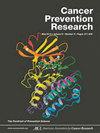Stool protein mass spectrometry identifies biomarkers for the early detection of diffuse-type gastric cancer
IF 2.6
3区 医学
Q2 ONCOLOGY
引用次数: 0
Abstract
There is a high unmet need for early detection approaches for diffuse gastric cancer (DGC). We examined whether the stool proteome of mouse models of GC or individuals with hereditary diffuse GC (HDGC) have utility as biomarkers for early detection. Proteomic mass spectrometry of stool from a genetically engineered mouse model driven by oncogenic KrasG12D and loss of p53 and Cdh1 in gastric parietal cells (known as TCON mice) identified differentially abundant proteins compared to littermate controls. Immunoblot assays validated a panel of proteins including actinin alpha 4 (ACTN4), N-acylsphingosine amidohydrolase 2 (ASAH2), dipeptidyl peptidase 4 (DPP4), and valosin-containing protein (VCP) as enriched in TCON stool compared to littermate control stool. Immunofluorescence analysis of these proteins in TCON stomach sections revealed increased protein expression as compared to littermate controls. Proteomic mass spectrometry of stool obtained from HDGC patients with CDH1 mutations identified increased expression of ASAH2, DPP4, VCP, lactotransferrin (LTF), and tropomyosin-2 (TPM2) relative to stool from healthy sex and age-matched donors. Chemical inhibition of ASAH2 using C6-urea ceramide was toxic to GC cell lines and patient derived-GC organoids. This toxicity was reversed by adding downstream products of the S1P synthesis pathway, suggesting a dependency on ASAH2 activity in GC. An exploratory analysis of the HDGC stool microbiome identified features which correlated with patient tumors. Here we provide evidence supporting the potential of analyzing stool biomarkers for the early detection of DGC.粪便蛋白质谱法确定早期检测弥漫型胃癌的生物标记物
弥漫性胃癌(DGC)早期检测方法的需求尚未得到满足。我们研究了胃癌小鼠模型或遗传性弥漫性胃癌(HDGC)患者的粪便蛋白质组是否可作为早期检测的生物标记物。我们对一种由致癌基因 KrasG12D 和胃顶细胞中 p53 和 Cdh1 缺失驱动的基因工程小鼠模型(称为 TCON 小鼠)的粪便进行了蛋白质组质谱分析,发现了与同窝对照组相比不同的丰富蛋白质。免疫印迹检测验证了一组蛋白质,包括肌动蛋白α4 (ACTN4)、N-酰鞘苷酸酰胺水解酶 2 (ASAH2)、二肽基肽酶 4 (DPP4) 和含缬氨酸蛋白 (VCP),与同卵对照组相比,TCON 小鼠粪便中富含这些蛋白质。对 TCON 胃切片中这些蛋白质的免疫荧光分析表明,与同窝对照组相比,这些蛋白质的表达量有所增加。对 CDH1 基因突变的 HDGC 患者的粪便进行蛋白质组质谱分析发现,与性别和年龄匹配的健康供体的粪便相比,ASAH2、DPP4、VCP、乳转铁蛋白 (LTF) 和肌球蛋白-2 (TPM2) 的表达量增加。使用 C6-urea 神经酰胺对 ASAH2 进行化学抑制会对 GC 细胞系和患者衍生的 GC 器官组织产生毒性。加入 S1P 合成途径的下游产物可逆转这种毒性,这表明 GC 对 ASAH2 活性有依赖性。对 HDGC 粪便微生物组的探索性分析发现了与患者肿瘤相关的特征。我们在此提供的证据支持了分析粪便生物标记物以早期检测 DGC 的潜力。
本文章由计算机程序翻译,如有差异,请以英文原文为准。
求助全文
约1分钟内获得全文
求助全文
来源期刊

Cancer Prevention Research
医学-肿瘤学
CiteScore
6.00
自引率
3.00%
发文量
173
审稿时长
1 months
期刊介绍:
Cancer Prevention Research publishes original studies, reviews, and perspectives in the field of cancer prevention. Its scope includes the molecular and cellular biology of premalignancy and early lesions; genetic and environmental risk factors; risk assessment and reduction; early detection research (cancer screening and diagnosis); and preventive interventions (chemoprevention, immunoprevention, and others) to intercept cancer development at early stages prior to initiation, promotion, or progression. The journal comprises preclinical, clinical, and translational research, with special attention given to molecular discoveries and an emphasis on building a translational bridge between the basic and clinical sciences.
 求助内容:
求助内容: 应助结果提醒方式:
应助结果提醒方式:


